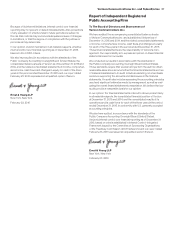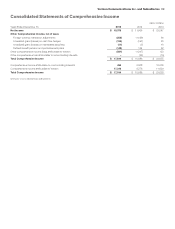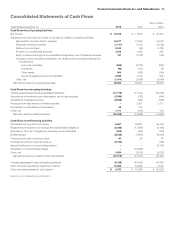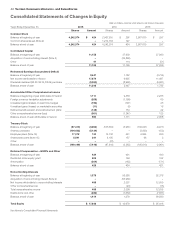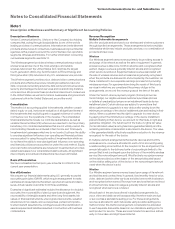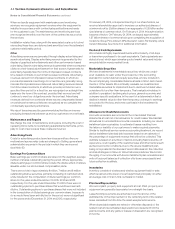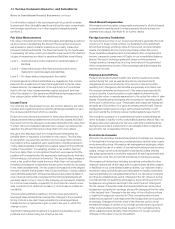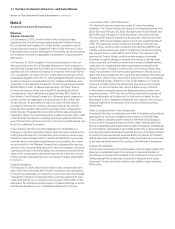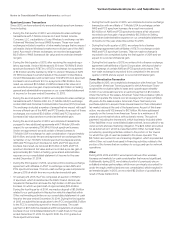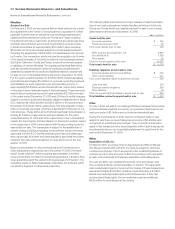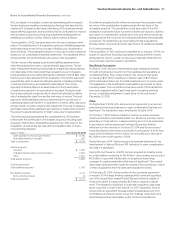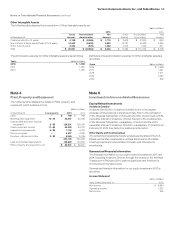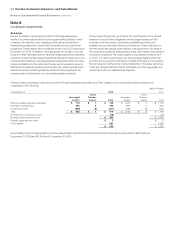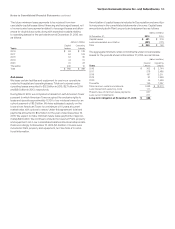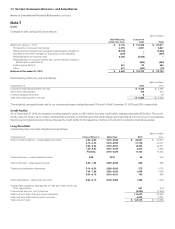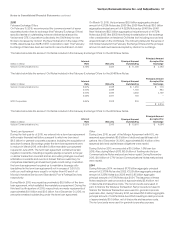America Online 2015 Annual Report Download - page 49
Download and view the complete annual report
Please find page 49 of the 2015 America Online annual report below. You can navigate through the pages in the report by either clicking on the pages listed below, or by using the keyword search tool below to find specific information within the annual report.Variable Interest Entities
VIEs are entities which lack sufficient equity to permit the entity to
finance its activities without additional subordinated financial support
from other parties, have equity investors which do not have the ability
to make significant decisions relating to the entity’s operations through
voting rights, do not have the obligation to absorb the expected losses,
or do not have the right to receive the residual returns of the entity. We
consolidate the assets and liabilities of VIEs when we are deemed to
be the primary beneficiary. The primary beneficiary is the party which
has the power to make the decisions that most significantly affect the
economic performance of the VIE and has the obligation to absorb
losses or the right to receive benefits that could potentially be signifi-
cant to the VIE.
Recently Adopted Accounting Standards
During the first quarter of 2015, we adopted the accounting standard
update related to the reporting of discontinued operations and dis-
closures of disposals of components of an entity, which changes
the criteria for reporting discontinued operations. As a result of this
standard update, a disposal of a component of an entity or a group
of components of an entity is required to be reported in discontinued
operations if the disposal represents a strategic shift that has, or will
have, a major effect on an entity’s operations and financial results. The
prospective adoption of this standard update did not have an impact
on our consolidated financial statements.
During the fourth quarter of 2015, we early adopted the accounting
standard update related to the balance sheet classification of deferred
taxes. The standard update requires that deferred tax liabilities
and assets be classified as noncurrent in the statement of financial
position. We applied the amendments in this accounting standard
update retrospectively to all periods presented. The adoption of this
standard update did not have a significant impact on our consolidated
financial statements.
Recently Issued Accounting Standards
In September 2015, the accounting standard update related to the
simplification of the accounting for measurement- period adjustments
in business combinations was issued. This standard update requires
an acquirer to recognize measurement- period adjustments in the
reporting period in which the adjustments are determined and to
record the effects on earnings of any changes resulting from the
change in provisional amounts, calculated as if the accounting had
been completed at the acquisition date. We will adopt this standard
update during the first quarter of 2016. The adoption of this standard
update is not expected to have a significant impact on our consoli-
dated financial statements.
In May 2015, the accounting standard update related to disclosures for
investments in certain entities that calculate net asset value per share
was issued. This standard update removes the requirement to catego-
rize within the fair value hierarchy all investments for which fair value
is measured using the net asset value per share practical expedient.
The standard update also removes the requirement to make certain
disclosures for all investments that are eligible to be measured at fair
value using the net asset value per share practical expedient. We will
adopt this standard update during the first quarter of 2016 and apply it
retrospectively to all periods presented. The adoption of this standard
update is not expected to have a significant impact on our consoli-
dated financial statements.
In April 2015, the accounting standard update related to the sim-
plification of the presentation of debt issuance costs was issued.
This standard update requires that debt issuance costs related to a
recognized debt liability be presented in the balance sheet as a direct
deduction from the carrying amount of that debt liability. In August
2015, the accounting standard update related to the presentation and
subsequent measurement of debt issuance costs associated with
line-of- credit arrangements was issued. This standard adds Securities
and Exchange Commission (SEC) paragraphs pursuant to an SEC
Staff Announcement that the SEC staff would not object to an entity
deferring and presenting debt issuance costs associated with a line-
of- credit arrangement as an asset and subsequently amortizing the
costs ratably over the term of the arrangement. We will adopt these
standard updates during the first quarter of 2016. The adoption of
these standard updates is not expected to have a significant impact on
our consolidated financial statements.
In June 2014, an accounting standard update was issued related
to the accounting for share-based payments when the terms of an
award provide that a performance target could be achieved after the
requisite service period. The standard update requires that a perfor-
mance target that affects vesting and that could be achieved after the
requisite service period be treated as a performance condition. We
will adopt this standard update during the first quarter of 2016. The
adoption of this standard update is not expected to have a significant
impact on our consolidated financial statements.
In May 2014, the accounting standard update related to the recognition
of revenue from contracts with customers was issued. This standard
update clarifies the principles for recognizing revenue and develops a
common revenue standard for U.S. GAAP and International Financial
Reporting Standards. The standard update intends to provide a more
robust framework for addressing revenue issues; improve compa-
rability of revenue recognition practices across entities, industries,
jurisdictions, and capital markets; and provide more useful information
to users of financial statements through improved disclosure require-
ments. Upon adoption of this standard update, we expect that the
allocation and timing of revenue recognition will be impacted. In August
2015, an accounting standard update was issued that delays the
effective date of this standard until the first quarter of 2018. Companies
are permitted to early adopt the standard in the first quarter of 2017.
There are two adoption methods available for implementation of the
standard update related to the recognition of revenue from contracts
with customers. Under one method, the guidance is applied retro-
spectively to contracts for each reporting period presented, subject to
allowable practical expedients. Under the other method, the guidance
is applied only to the most current period presented, recognizing the
cumulative effect of the change as an adjustment to the beginning
balance of retained earnings, and also requires additional disclosures
comparing the results to the previous guidance. We are currently
evaluating these adoption methods and the impact that this standard
update will have on our consolidated financial statements.
47Verizon Communications Inc. and Subsidiaries
Notes to Consolidated Financial Statements continued


